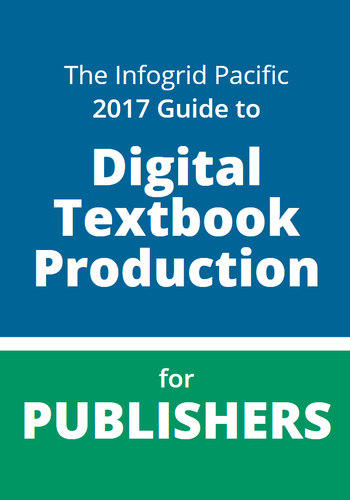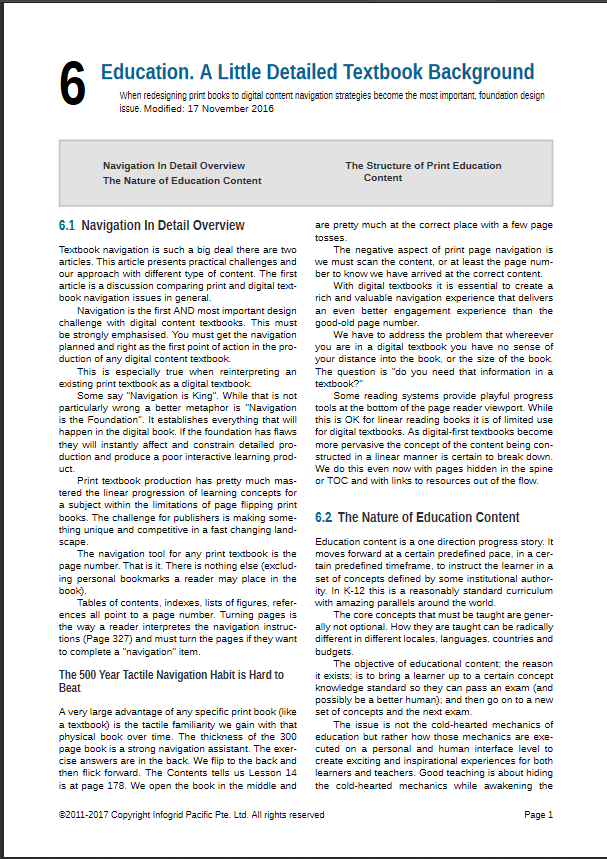Learn How to Digitize Textbooks and Create Better Education Content
30 May 2017
The challenge with textbook digitization is that education publishing is an incredibly wide field of content covering a wide range of age groups, book types and subjects. We address the challenge with our production guide.
Overview
The challenge with textbook digitization is that education publishing is an incredibly wide field of content covering a wide range of age groups, book types and subjects.
Added to the mix is that in some markets textbook publishing is a competitive business so making the same content different is important. That is without introducing the challenges of multiple language markets and politics!
Guide to Digital Textbook Production
(Coming soon to a browser/eBook Reader/PDF near you)

We will shortly be publishing "The IGP 2017 Guide to Digital Textbook Production". This is an objective tome based on our 15 years experience fighting the good fight converting print textbook content to real learning content.
The Guide is particularly designed to help regional publishers not in the Western mainstream to see many of the lessons learned; and to help them transform print textbooks into cost effective and powerful teaching and learning tools. The narrative is about education publisher strategies. In the examples we use IGP:Digital Publisher for "Digitize Once. Use Forever" production, AZARDI:Content Fulfilment for the controlled and secure of digital ePub3 books and IGP:Digital Library for the controlled and secure delivery of online textbooks and additional learning resources.
The Textbook Dimensions
The term "textbook" is arguably one of the most general publishing terms. It encapsulates the teaching/learning aspect of education content but does not address the incredible range and complexity of education content in production or for digitization and digital delivery business strategies.
In addition there are endless online free and paid-for learning resources that complicate the discussion. Are these resources the new competition for textbook publishers? Or do they make digital textbooks more relevant?
Let's quickly list some of the textbook dimension variety:
Age
- Kindergarten
- Basic standards
- Transitional standards
- High standards
- Diploma institutions
- Tertiary institutions.
Subjects
The subjects are even more challenging. This list is only slightly representative of education subjects
- Reading/Writing
- Numbers/Maths
- Other language learning
- History
- Geography
- Science
- Tertiary - any subject of which you can think
Of course there are specific collections such as the STEM classification which is fine as a subject bucket, but when you see the textbooks for Science, Technology, Engineering and Maths, the textbooks are as related as two distant galaxies.
And tertiary education has an infinite list of subjects and courses for everything else such as philosophy, classical studies, comparitive literature, politics, social sciences, median, language and regional studies and on and on...
In 2017 we have to add to this the availability of free Internet learning resources and "teach your Kiddie better" commercial interactive products.
Contents
At present The IGP 2017 Guide to Digital Textbook Production for Publishers covers the following subjects. This may be increased, decreased or changed as we move forward.
1. Education. Articles Overview
This first section is a short discussion on each of the following sections. Because this is a dynamically created document that is within the rules!
2. Education. Digital eBook and other delivery systems
This section covers the advantages and disadvantages of different online and offline delivery systems. It discusses the powers and problems with various platforms and their reading systems and our experiences with failures and successes.
3. Education. Digital Content Design and Production
This section takes a tentative step into into the digital content production swamp and discusses strategies and approaches to textbook digital deliver and the many options many publishers shy away from.
4. Education. Design Dimensions
It's more than just layout and pagination. This article introduces publishers to the myriad of design dimensions possible, but usually ignored.
5. Education. Deconstructing a Textbook
So you have been publishing textbooks for decades. Even have a digital content strategy in place. This section gives a new perspective on interpreting your current publishing into a dynamic digital content learning strategy. With print too of course!
6. Education. Navigation is the Foundation
Digatal content navigation in textbook content is more than the very limited ePub3 Page and TOC strategies. Learn how to create useful and learning navigation in multiple contexts.
7. Education. Search and Discovery Inside Textbooks
While most ePub Readers have limited "Find" capability, AZARDI Readers and IGP:Digital Library have full text search. While that may not apply for a junior student it helps explore expanding subjects as the student gets older.
8. Education. Rich Media, Interactivity or Both
A discussion on the pros and cons of additional learning tools and how they can even work from the limitations of a print PDF.
9. Education. The Multi-Language Challenge
Many publishers have to publish in multiple languages. We show you how to do that better, faster and at lower cost. But it does take change management. A lot of it.
10. Education. Interactive Enhancement and Delivery Tools
Not all interactivity needs to be in the book. Expanded digital content resources can be published to address multiple learning speeds, group activities and "gamefication" where appropriate.
Please excuse the repeating and obvious "Education" leader word on each article, but they are for Internet, e-Book, Online Library and PDF Publication, and written as stand-alone articles. No ambiguity is essential.
Get Ready to be digitally edumacated!

The default PDF will be A4. Get your printer ready!
We are aiming to release the articles at around two per week. The articles will also undergo updating as required and based on feedback requests and information. This is to demonstrate the concept of dynamic digital publishing rather than traditional static print publishing.
We will release the book in all formats. That means Online in the IGP:Digital Library, as a ePub3 in AZARDI:Content Fulfilment and as a Print PDF. We have yet to decide whether to do multiple print PDF editions to demonstrate the power of IGP:Digital Publisher. When the book is finished we will do an accessible print version.
As each article is completed it will be added to a book collection. By doing this you will be able to see the dynamic content publishing capabilities of IGP:Digital Library and AZARDI:Content Fulfilment.
Once everything is finished and beautiful the final full document will be published and available in all formats. All in the same IGP:Digital Library and AZARDI:Content Fulfilment collections. And of course in boring old print PDF!
The ePub3 files will be available from AZARDI:Content Fulfilment. You will need to make an account and purchase the books at no cost to access the ePub3 editions. We are doing this so publishers can understand the full workflow from production to deliver to end users.
Register for the blog posts below and you will be notified as each article is published.
Posted by Richard Pipe, Milan Bishwakarma, Govind Satpute, Bayanna Gettiboena.